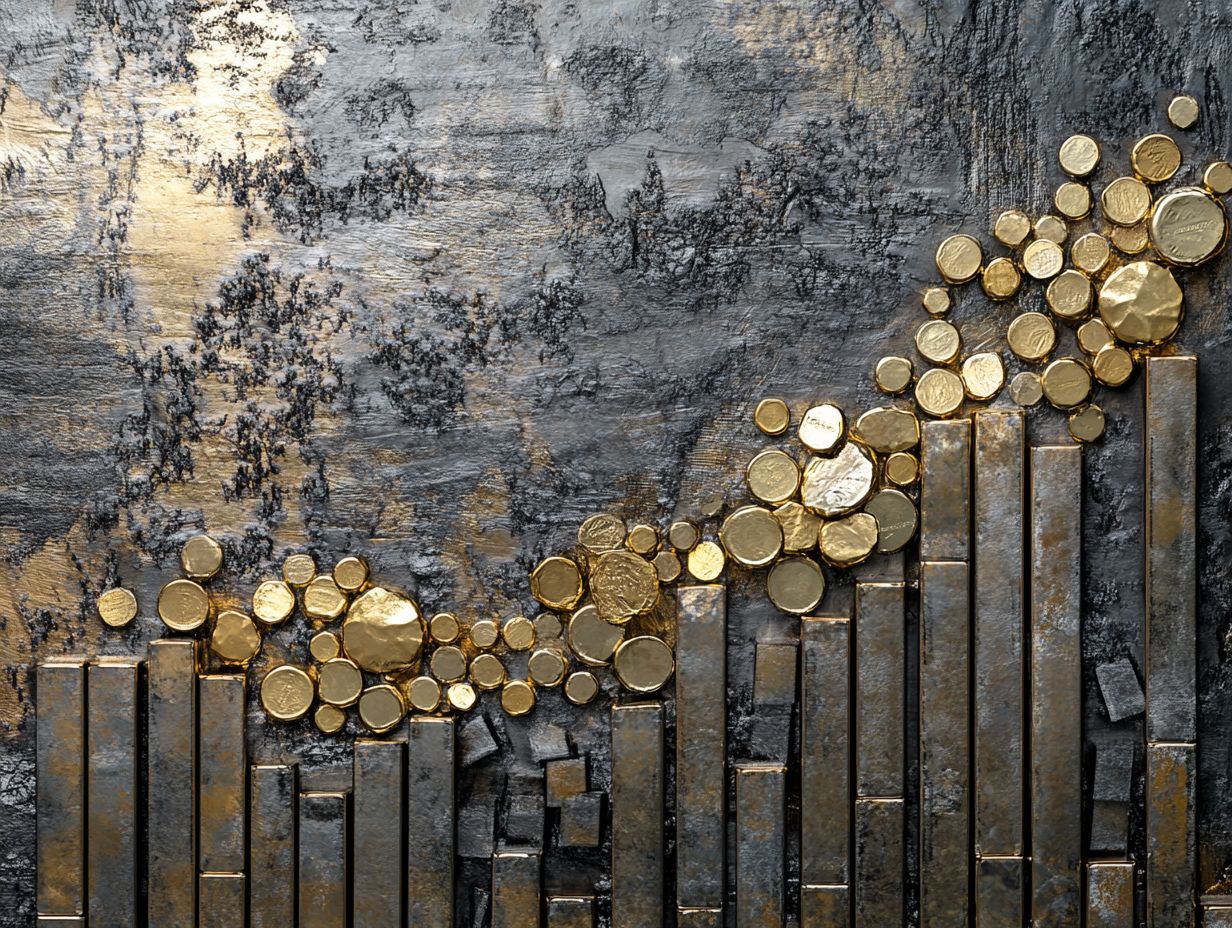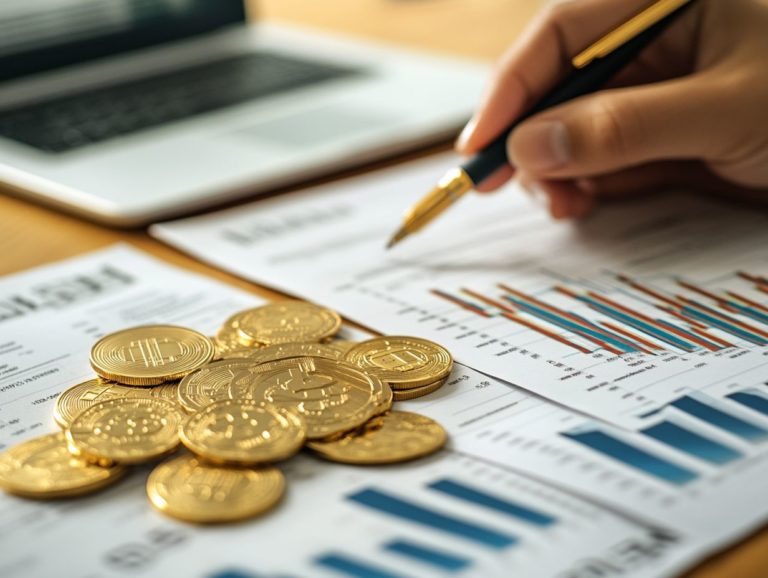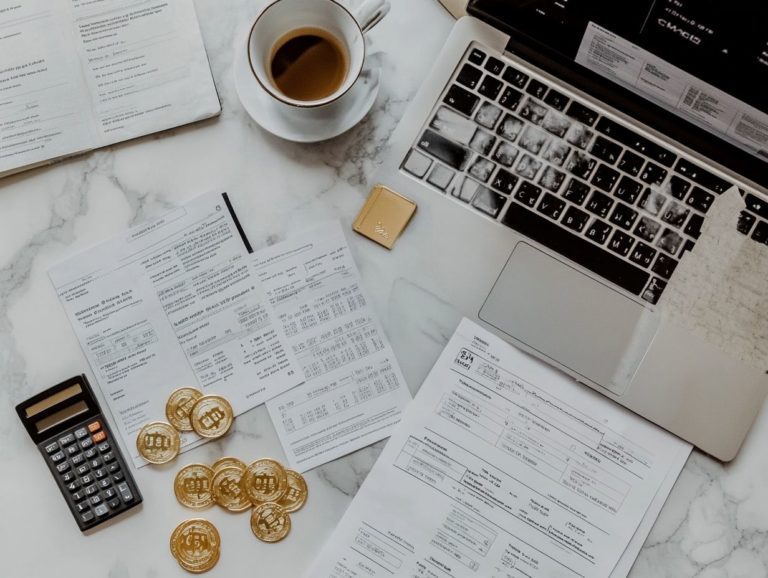Impact of Tax Incentives on Precious Metals Market
Tax incentives greatly influence how you invest in precious metals, affecting everything from your strategies to market trends.
This article explores essential concepts, including what tax incentives are and their various forms. It also examines their historical influence on precious metals and the factors that drive market fluctuations.
You will discover specific tax incentives available for investors, weigh potential risks against benefits, and explore predictions for the future of these incentives in a changing market landscape.
Whether you are a seasoned investor or simply intrigued by the intersection of taxation and precious metals, this article offers valuable insights to help you navigate this complex terrain.
Contents
- Key Takeaways:
- Understanding Tax Incentives
- Effects of Tax Incentives on the Precious Metals Market
- What Drives the Precious Metals Market?
- Tax Incentives for Investors in Precious Metals
- Potential Risks and Benefits
- Future Outlook for Tax Incentives and Precious Metals Market
- Frequently Asked Questions
- How do tax incentives affect the precious metals market?
- What are some common tax incentives for investing in precious metals?
- Do tax incentives always have a positive impact on the precious metals market?
- How do tax incentives for precious metals differ from other types of tax breaks?
- Are tax incentives the only factor that affects the precious metals market?
- How can I stay informed about changes in tax incentives for precious metals?
Key Takeaways:
- Tax incentives, such as exemptions and deductions, can significantly impact the demand for precious metals in the market.
- Historical trends and predictions show that tax incentives for investing in precious metals can influence market prices and stimulate investment activity.
- Economic conditions and government policies are key factors that affect the effectiveness of tax incentives on the precious metals market.
Understanding Tax Incentives
Understanding tax incentives is essential for investors navigating the complex landscape of precious metals investments, including gold, silver, and platinum. These incentives can significantly shape your financial decisions regarding wealth preservation and portfolio diversification.
Tax incentives come in various forms, such as tax benefits and deductions. Each carries substantial implications for capital gains tax, which is the tax you pay on profits from selling investments, especially for assets stored in tax-deferred accounts like Individual Retirement Accounts (IRA) and Roth IRAs. Being aware of these nuances can help you make informed choices that enhance your investment strategy.
Definition and Types
Tax incentives are financial perks offered by the government to encourage behaviors such as investments in precious metals. These investments can unlock various tax benefits and deductions for you.
Incentives manifest in several ways, including capital gains tax exemptions and deductions that help reduce your taxable income. For example, when you sell your precious metal investments, the capital gains tax rates you face may vary depending on how long you’ve held those assets. According to IRS regulations, certain bullion and coins can be classified as collectibles, which can lead to distinct tax implications.
It is crucial to stay informed about compliance requirements, such as accurately reporting any sales or swaps of precious metals. This diligence will ensure you meet IRS standards while maximizing your tax advantages.
Effects of Tax Incentives on the Precious Metals Market
The effects of tax incentives on the precious metals market are complex. They influence your investment behavior, market trends, and pricing dynamics, particularly for assets like gold, silver, and platinum. This is especially evident during times of economic uncertainty and shifts in fiscal policy.
Historical patterns show that favorable tax conditions can stimulate demand. Predictions indicate that future tax incentives will be vital in shaping your market strategies as an investor.
Historical Trends and Predictions
Historical trends in the precious metals market show that tax incentives often influence investor behavior. This is particularly true during inflation and economic uncertainty.
For instance, in the 1980s, specific tax breaks prompted citizens to invest in gold to hedge against rising prices. This led to a remarkable increase in its value.
Fast forward to the aftermath of the 2008 financial crisis, and you’ll see similar patterns. Government policies aimed at stimulating growth inadvertently directed investors toward safe-haven assets.
Now, as inflationary pressures mount and policies adjust, analysts predict a new surge in demand for these precious metals. If tax incentives return or improve, both institutional and retail investors may show renewed interest.
What Drives the Precious Metals Market?
A myriad of factors shapes the precious metals market, including economic conditions, government policies, and tax incentives. These elements act as an effective hedge against inflation and influence the demand for gold, silver, and platinum in your portfolio.
Understanding these dynamics is key to making informed investment decisions and seizing opportunities presented by market fluctuations.
Economic Conditions and Government Policies
Economic conditions and government policies are crucial in shaping the dynamics of the precious metals market. They directly impact your investment sentiment and the demand for gold, silver, and platinum.
When inflation rates surge and economic uncertainty looms, many investors turn to these metals, which tend to hold their value even when fiat currencies falter.
Government decisions regarding fiscal policies—such as changes in taxation or spending—can drastically alter the market landscape. For example, tax incentives designed to stimulate investments might drive up demand for precious metals, while austerity measures could stifle consumer spending.
Ultimately, the interplay of these economic indicators creates a complex backdrop that influences how you navigate your portfolio during turbulent times.
Tax Incentives for Investors in Precious Metals
Tax incentives for investing in precious metals, like gold, silver, and platinum, can elevate your financial outcomes when strategically utilized through tax-deferred accounts such as Individual Retirement Accounts (IRA) and Roth IRAs. This approach facilitates effective wealth preservation and enhances your portfolio diversification.
Understanding this is key to your success! It’s essential to know the eligibility criteria for these tax benefits and how to leverage them to minimize your overall tax implications, ensuring a prosperous investment journey.
Types and Eligibility Criteria
The types of tax incentives available for precious metals investors include:
- Long-term capital gains rates: If you hold your metals for over a year, you may benefit from reduced taxation on your profits compared to short-term gains.
- Self-Directed IRAs: Certain retirement accounts enable you to invest in physical precious metals, providing tax-deferred growth on your assets.
It’s essential to ensure that your metals meet specific purity standards to qualify for these advantages. Understanding local regulations is vital, as some states offer sales tax exemptions on precious metal purchases, making these investments even more appealing for diversifying your portfolio.
Potential Risks and Benefits
Investing in precious metals presents a unique combination of potential risks and rewards. This is especially true when considering tax implications, capital gains tax, and the overall effects on your portfolio diversification and wealth preservation strategies.
Assessing the Impact on Investments
Investing in precious metals involves considering tax implications, market conditions, and potential returns. Returns can vary based on whether you hold gold, silver, or platinum.
Examine how tax structures like long-term capital gains taxes affect profit margins. A diversified portfolio should include a thorough market analysis based on research and real-world experience.
Knowing each metal’s unique characteristics helps you understand their roles in protecting against inflation and economic downturns. This approach is vital for effective wealth management.
By strategically evaluating these parameters, you can navigate the complexities of your investments in a tax-efficient manner.
Future Outlook for Tax Incentives and Precious Metals Market
The outlook for tax incentives and the precious metals market is influenced by economic changes and government policies. This creates both opportunities and challenges for investors.
To maximize returns in this asset class, recognize how favorable tax incentives align with market trends. Staying informed will help you navigate this evolving terrain effectively.
Predictions and Recommendations
Predictions indicate that tax incentives will continue to impact investment choices. With the right strategy, you can confidently handle market changes.
Expect fluctuations in demand, particularly for gold and silver, which are well-regarded as safe havens. Consider diversifying your portfolio by dedicating a portion to precious metals, especially during times of economic uncertainty or when interest rates rise.
Staying informed about legislative developments can give you a significant advantage. Understand how different tax treatments on bullion purchases compare to other investments, as this can impact your overall returns.
Regularly consulting with financial advisors who specialize in precious metals can help you optimize your strategies and enhance your long-term growth potential.
Frequently Asked Questions
How do tax incentives affect the precious metals market?
Tax incentives can boost demand for precious metals, increasing their market value. When governments offer tax breaks or deductions for purchasing precious metals, it can drive up the demand for these assets.
What are some common tax incentives for investing in precious metals?
Some common tax incentives for investing in precious metals include lower capital gains taxes, tax-deferred accounts such as IRAs, and tax-free exchanges, also known as 1031 exchanges.
Do tax incentives always have a positive impact on the precious metals market?
No, tax incentives can also have a negative impact on the precious metals market. For example, if a sudden change in tax policy makes it less favorable for investors to hold precious metals, it can lead to a decrease in demand and a decline in market value.
How do tax incentives for precious metals differ from other types of tax breaks?
Tax incentives for precious metals often have a longer-term impact compared to other types of tax breaks. This is because precious metals are seen as a store of value and are often held for extended periods, meaning the effects of tax incentives can be seen over a longer time frame.
Are tax incentives the only factor that affects the precious metals market?
No, tax incentives are just one of many factors influencing the precious metals market. Economic conditions, global events like conflicts or diplomatic relations, and supply and demand also significantly impact the market value.
How can I stay informed about changes in tax incentives for precious metals?
To stay updated on changes in tax policies, regularly check government websites. You can also consult with a financial advisor or follow reputable news sources that cover the precious metals market.

















